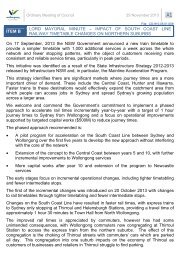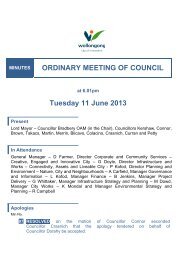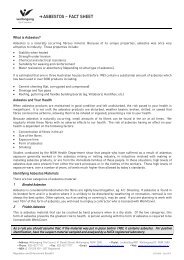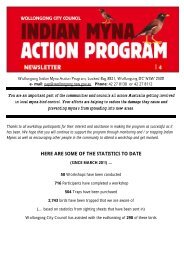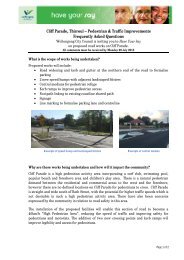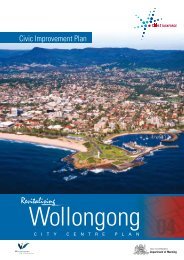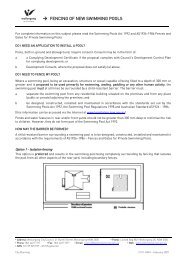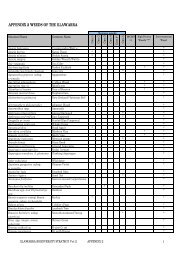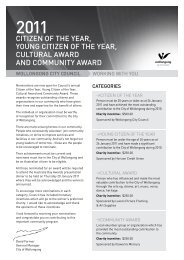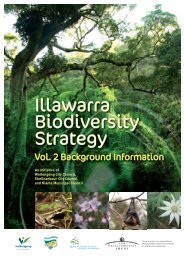Minnegang Creek Flood Study Report - Wollongong City Council
Minnegang Creek Flood Study Report - Wollongong City Council
Minnegang Creek Flood Study Report - Wollongong City Council
- No tags were found...
Create successful ePaper yourself
Turn your PDF publications into a flip-book with our unique Google optimized e-Paper software.
To determine the peak flow from the entire catchment, lag times were added betweeneach node in the RAFTS model. Some links between sub-catchments originallyincluded lag times as discussed in Section 4.2. For the remaining sub-catchments, lagtimes were estimated for this calibration process to be between one and two minutes.The lag times were not calculated more accurately as the routing of hydrographs fromthese sub-catchments was carried out in the hydraulic model. The one and two minutelag estimates compared well to those subsequently calculated in the hydraulicmodelling of the catchment.Table 4-3 shows the comparison between the peak flow from RAFTS and the PRMflows. It shows that the flows from RAFTS compare well with the PRM flows.Table 4-3 Comparison of RAFTS and PRM flows (m 3 /s)AEP RAFTS 1 min lag RAFTS 2 min lag PRM1% 35.7 28.4 34.45% 28.3 22.2 24.820% 21.7 17.2 15.2The time of concentration for PRM calculations as summarised in Table 4-3 was 43minutes. RAFTS flows were calculated for a range of storm durations, ranging from30 minutes to 3 hours. The peak flow in each case resulted from the 2 hour stormevent.4.6 MODEL SENSITIVITY ANALYSISThe robustness of the RAFTS model was checked by considering the flows fordifferent parameter sets. The parameters used in the RAFTS model, such as rainfalllosses, imperviousness and Manning’s n value, were varied to assess the sensitivity ofthe model to the chosen parameters. The sensitivity analyses were carried outassuming a lag time of 1 minute between each sub-catchment, so that total flows ateach sub-catchment and thus for the entire catchment could be considered.The changes in the predicted flow at each sub-catchment were approximately 5% to20%, for the various changes in the model parameters. The model was more sensitiveto changes in parameters for the 20% AEP event than for the 1% AEP event,particularly for changes to the rainfall losses. For the 5% AEP event, flows were up to40% lower than the adopted flows if higher rainfall losses were adopted in the model.However, it is considered that the adopted losses are reasonable for the catchment andthe flows resulting from these losses are conservative.The sensitivity analysis indicates that reasonable variations to the adopted parameterswould not significantly alter the results and thus the parameters discussed inSection 4.3 should be adopted for the modelling. Total flows at each sub-catchmentfrom the sensitivity analyses are shown in Appendix D.4.7 FUTURE DEVELOPMENT CONDITIONSTo assess the effects that future development may have on flooding within thecatchment, land zoning presented in <strong>Council</strong>’s Local Environmental Plan (1990) wasconsidered. Urban consolidation as defined in <strong>Council</strong>’s Urban Consolidation PolicySV8507-D0-001 Rev 2 4-1318/10/02



